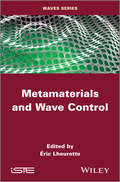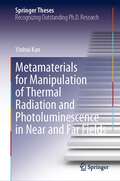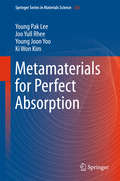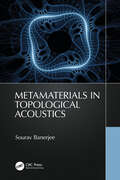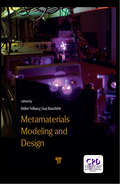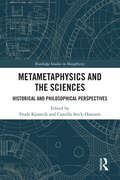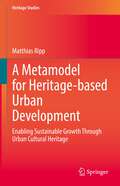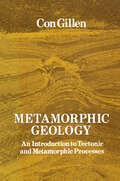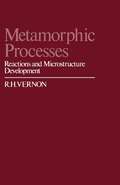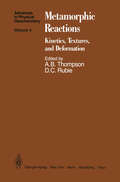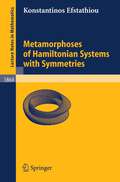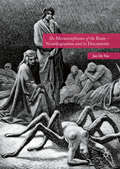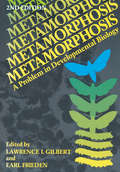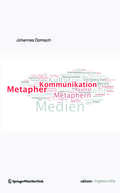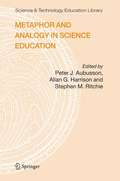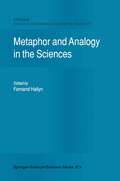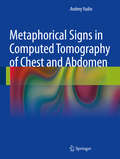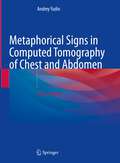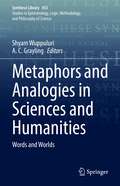- Table View
- List View
Metamaterials and Wave Control
by Eric LheuretteSince the concept was first proposed at the end of the 20th Century, metamaterials have been the subject of much research and discussion throughout the wave community. More than 10 years later, the number of related published articles is increasing significantly. On the one hand, this success can be attributed to dreams of new physical objects which are the consequences of the singular properties of metamaterials. Among them, we can consider the examples of perfect lensing and invisibility cloaking. On other hand, metamaterials also provide new tools for the design of well-known wave functions such as antennas for electromagnetic waves. The goal of this book is to propose an overview of the concept of metamaterials as a perspective on a new practical tool for wave study and engineering. This includes both the electromagnetic spectrum, from microwave to optics, and the field of acoustic waves. Contents 1. Overview of Microwave and Optical Metamaterial Technologies, Didier Lippens. 2. MetaLines: Transmission Line Approach for the Design of Metamaterial Devices, Bruno Sauviac. 3. Metamaterials for Non-Radiative Microwave Functions and Antennas, Divitha Seetharamdoo and Bruno Sauviac. 4. Toward New Prospects for Electromagnetic Compatibility, Divitha Seetharamdoo. 5. Dissipative Loss in Resonant Metamaterials, Philippe Tassin, Thomas Koschny, and Costas M. Soukoulis. 6. Transformation Optics and Antennas, André de Lustrac, Shah Nawaz Burokur and Paul-Henri Tichit. 7. Metamaterials for Control of Surface Electromagnetic and Liquid Waves, Sébastien Guenneau, Mohamed Farhat, Muamer Kadic, Stefan Enoch and Romain Quidant. 8. Classical Analog of Electromagnetically Induced Transparency, Philippe Tassin, Thomas Koschny and Costas M. Soukoulis.
Metamaterials for Manipulation of Thermal Radiation and Photoluminescence in Near and Far Fields (Springer Theses)
by Yinhui KanThis book provides a series of methods for flexibly and actively manipulating thermal emission and photoluminance by advanced nanostructures—metamaterials. Nanostructures in subwavelength scales can be designed to precisely modulate light-matter interactions and thereby tailoring both thermal radiations and photon emissions. This book explores approaches for designing different kinds of nanostructures, including multilayers, gratings, nanoridges, and waveguides, to improve the flexibility and functionality of micro/nanodevices. With the help of these subwavelength nanostructures, thermal radiation and photoluminescence have been fully manipulated in near and far fields regarding to the intensity, spectrum, polarization, and direction. The proposed methods together with designed metamaterials open new avenues for designing novel micro-/nanodevices or systems for promising applications like thermal energy harvesting, detecting, sensing, and on-chip quantum-optical networks.
Metamaterials for Perfect Absorption (Springer Series in Materials Science #236)
by Young Pak Lee Joo Yull Rhee Young Joon Yoo Ki Won KimThis book provides a comprehensive overview of the theory and practical development of metamaterial-based perfect absorbers (MMPAs). It begins with a brief history of MMPAs which reviews the various theoretical and experimental milestones in their development. The theoretical background and fundamental working principles of MMPAs are then discussed, providing the necessary background on how MMPAs work and are constructed. There then follows a section describing how different MMPAs are designed and built according to the operating frequency of the electromagnetic wave, and how their behavior is changed. Methods of fabricating and characterizing MMPAs are then presented. The book elaborates on the performance and characteristics of MMPAs, including electromagnetically-induced transparency (EIT). It also covers recent advances in MMPAs and their applications, including multi-band, broadband, tunability, polarization independence and incidence independence. Suitable for graduate students in optical sciences and electronic engineering, it will also serve as a valuable reference for active researchers in these fields.
Metamaterials in Topological Acoustics
by Sourav BanerjeeAs an equivalent counterpart of topological research on photonics and condensed matter physics, acoustic metamaterials create an opportunity to explore the topological behaviors in phononics and physics of programmable acoustics. This book introduces the topological behavior of acoustics through the novel design of metamaterials. It provides valuable insight into acoustic metamaterials, from multidisciplinary fundamentals to cutting-edge research. Serves as a single resource on acoustic metamaterials Covers the fundamentals of classical mechanics, quantum mechanics, and state-of-the-art condensed matter physics principles so that topological acoustics can be easily understood by engineers Introduces topological behaviors with acoustics and elastic waves through quantum analogue Hall effects, quantum spin Hall effects, and quantum valley Hall effects and their applications Explains the pros and cons of different design methods and gives guidelines for selecting specific designs of acoustic metamaterials with specific topological behaviors Includes MATLAB® code for numerical analysis of band structures This book is written for graduate students, researchers, scientists, and professionals across materials, mechanical, civil, and aerospace engineering, and those who want to enhance their understanding and commence research in metamaterials.
Metamaterials in Topological Acoustics
by Sourav BanerjeeAs an equivalent counterpart of topological research on photonics and condensed matter physics, acoustic metamaterials create an opportunity to explore the topological behaviors in phononics and physics of programmable acoustics. This book introduces the topological behavior of acoustics through the novel design of metamaterials. It provides valuable insight into acoustic metamaterials, from multidisciplinary fundamentals to cutting-edge research. Serves as a single resource on acoustic metamaterials Covers the fundamentals of classical mechanics, quantum mechanics, and state-of-the-art condensed matter physics principles so that topological acoustics can be easily understood by engineers Introduces topological behaviors with acoustics and elastic waves through quantum analogue Hall effects, quantum spin Hall effects, and quantum valley Hall effects and their applications Explains the pros and cons of different design methods and gives guidelines for selecting specific designs of acoustic metamaterials with specific topological behaviors Includes MATLAB® code for numerical analysis of band structures This book is written for graduate students, researchers, scientists, and professionals across materials, mechanical, civil, and aerospace engineering, and those who want to enhance their understanding and commence research in metamaterials.
Metamaterials Modelling and Design
by Didier Felbacq Guy BouchittéThe domain of metamaterials now covers many area of physics: electromagnetics, acoustics, mechanics, thermics, or even seismology. Huge literature is now available on the subject but the results are scattered. Although many ideas and possible applications have been proposed, which of these will emerge as a viable technology will only unfold with time. This book covers the fundamental science behind metamaterials, from the physical, mathematical, and numerical points of view, focusing mainly on methods. It concentrates on electromagnetic waves, but would also be useful in studying other types of metamaterials. It presents the structure of Maxwell equations, discusses the homogenization theory in detail, and includes important problems on resonance. It has an entire section devoted to numerical methods (finite elements, Fourier modal methods, scattering theory), which aims to motivate a reader to implement them. The book is not written as a collection of independent chapters but as a textbook with a strong pedagogical flavor.
Metamaterials Modelling and Design
by Didier Felbacq Guy BouchittéThe domain of metamaterials now covers many area of physics: electromagnetics, acoustics, mechanics, thermics, or even seismology. Huge literature is now available on the subject but the results are scattered. Although many ideas and possible applications have been proposed, which of these will emerge as a viable technology will only unfold with time. This book covers the fundamental science behind metamaterials, from the physical, mathematical, and numerical points of view, focusing mainly on methods. It concentrates on electromagnetic waves, but would also be useful in studying other types of metamaterials. It presents the structure of Maxwell equations, discusses the homogenization theory in detail, and includes important problems on resonance. It has an entire section devoted to numerical methods (finite elements, Fourier modal methods, scattering theory), which aims to motivate a reader to implement them. The book is not written as a collection of independent chapters but as a textbook with a strong pedagogical flavor.
Metametaphysics and the Sciences: Historical and Philosophical Perspectives (Routledge Studies in Metaphysics)
by Frode Kjosavik Camilla Serck-HanssenThis collection addresses metaphysical issues at the intersection between philosophy and science. A unique feature is the way in which it is guided both by history of philosophy, by interaction between philosophy and science, and by methodological awareness. In asking how metaphysics is possible in an age of science, the contributors draw on philosophical tools provided by three great thinkers who were fully conversant with and actively engaged with the sciences of their day: Kant, Husserl, and Frege. Part I sets out frameworks for scientifically informed metaphysics in accordance with the meta-metaphysics outlined by these three self-reflective philosophers. Part II explores the domain for co-existent metaphysics and science. Constraints on ambitious critical metaphysics are laid down in close consideration of logic, meta-theory, and specific conditions for science. Part III exemplifies the role of language and science in contemporary metaphysics. Quine’s pursuit of truth is analysed; Cantor’s absolute infinitude is reconstrued in modal terms; and sense is made of Weyl’s take on the relationship between mathematics and empirical aspects of physics. With chapters by leading scholars, Metametaphysics and the Sciences is an in-depth resource for researchers and advanced students working within metaphysics, philosophy of science, and the history of philosophy.
Metametaphysics and the Sciences: Historical and Philosophical Perspectives (Routledge Studies in Metaphysics)
by Frode Kjosavik Camilla Serck-HanssenThis collection addresses metaphysical issues at the intersection between philosophy and science. A unique feature is the way in which it is guided both by history of philosophy, by interaction between philosophy and science, and by methodological awareness. In asking how metaphysics is possible in an age of science, the contributors draw on philosophical tools provided by three great thinkers who were fully conversant with and actively engaged with the sciences of their day: Kant, Husserl, and Frege. Part I sets out frameworks for scientifically informed metaphysics in accordance with the meta-metaphysics outlined by these three self-reflective philosophers. Part II explores the domain for co-existent metaphysics and science. Constraints on ambitious critical metaphysics are laid down in close consideration of logic, meta-theory, and specific conditions for science. Part III exemplifies the role of language and science in contemporary metaphysics. Quine’s pursuit of truth is analysed; Cantor’s absolute infinitude is reconstrued in modal terms; and sense is made of Weyl’s take on the relationship between mathematics and empirical aspects of physics. With chapters by leading scholars, Metametaphysics and the Sciences is an in-depth resource for researchers and advanced students working within metaphysics, philosophy of science, and the history of philosophy.
A Metamodel for Heritage-based Urban Development: Enabling Sustainable Growth Through Urban Cultural Heritage (Heritage Studies)
by Matthias RippThis book proposes a Metamodel for heritage-based urban development, based on urban morphology, governance theory, and the metamodeling concept of John P. Van Gigch. Building on international policies such as the 2011 Recommendation for Historic Urban Landscapes and the results of the 2016 Urban Habitat III Conference, cultural heritage is now regarded as a potential resource for sustainable urban development. While more and more evidence of the potential benefits of cultural heritage for sustainable development has been published, this book is the first to develop and design a Metamodel that can be universally applied in a wide variety of settings. The Metamodel was developed using grounded theory and design research methodology and is based on three successful case-models from European contexts. The book includes three application scenarios that elaborate how the metamodel can be used to design, evaluate, and improve processes where cultural heritage is a starting point for sustainable urban development.
Metamorphic Geology: An introduction to tectonic and metamorphic processes
by Cornelius GillenThis book is about metamorphic rocks: the processes involved in their formation and the reasons why they occur at particular places on the continents. It has been written to serve as an elementary text on the subjects of metamorphism and mountain building for non-specialist stu dents of geology. It will be equally useful where geology is either the main or subsidiary subject and could be used by students intending to advance further in geology (the list of advanced texts in the further reading section would be more appropriate to such students). My inten tion in writing this book has been to try to dispel the notion that metamorphism comprises the 'haunted wing' of geology. Admittedly, there are rather a large number of technical terms in the book, but I hope that after working through it you will not find metamorphism an unduly difficult or obscure aspect of geology. Throughout, I have emphasised the strong links between mountain building, plate tectonics and metamorphic processes. The book introduces metamorphic rocks by considering their textures and field relations, then moves on to deal with the factors controlling metamorphism. Case studies of areas of metamorphic rocks are then presented in the context of modern theories of the Earth's activity, and the place of metamorphic rocks in the formation of ancient and young mountain belts is analysed. New technical terms and concepts are explained in context as they are introduced, important terms being emphasised in bold print.
Metamorphic Processes: Reactions and Microstructure Development
by R. H. VernonThis book is for senior undergraduate or postgraduate students who want an insight into some modern approaches to metamorphic petrology. Its aims are to explain, in reasonably simple, informal terms, the processes underlying (i) metamorphic reactions and (ii) the production of micro structures in metamorphic rocks, these currently being the things that interest me most, geologically. The first aim requires discussion of equilibrium factors, reaction kinetics and reaction mechanisms, empha sising both the complexity of realistic reactions and the need to combine the chemical and microstructural approaches to them. The second aim requires discussion of deformation, recovery, recrystallisation and grain growth processes, with emphasis on experiments on silicate minerals. The book concludes with a general attempt to relate chemical and physical processes in metamorphism, although it will be clear from reading earlier chapters (especially Chapter 4) that the two aspects can rarely be separated completely in detailed metamorphic studies. Petrological and experimental investigations of metamorphic reactions and microstructural development are advancing so rapidly these days that students are faced with an ever-increasing volume of information and a relatively rapid obsolescence of data. So, in this book I do not try to be comprehensive, or to present much so-called 'factual' information. Instead, I deal more with basic principles, in the hope that these will guide the student in his or her encounters with the details of specific metamorphic problems.
Metamorphic Reactions: Kinetics, Textures, and Deformation (Advances in Physical Geochemistry #4)
by B. Bayly K. H. Brodie M. A. Carpenter R. J. Knipe E. L. McLellan S.A.F. Murrell A. Putnis J. Ridley D. C. Rubie E. H. Rutter B. K. Smith A. B. Thompson R. J. Tracy R. P. WintschThe fourth volume in this series consists of eleven chapters. The first five deal with more theoretical aspects of the kinetics and mechanisms of meta morphic reactions, and the next six consider the interdependence of defor mation and metamorphism. All papers deal with natural processes that inter act on various time scales and with different degrees of mass and heat transfer. Consequently, many fundamental axioms of metamorphic petrol ogy and structural geology are questioned both for their accuracy and their usefulness. In raising such questions, most contributors have pointed to ways in which the answers could be forthcoming from appropriate experi mental studies or observations on natural materials. In their discussion of how order/disorder can influence mineral assem blages, Carpenter and Putnis emphasize that metastable crystal growth is common in metamorphic systems and state' 'there may be some reluctance (among many earth scientists) to accept that significant departures from equilibrium could occur." On the basis of presented evidence, they question whether reactions ever occur close to an equilibrium boundary. The neces sity for pressure or temperature overstepping is also required by nucleation rate theory. In any case, the degree of order is severely influenced by these kinetic effects in igneous, sedimentary, and metamorphic environments.
Metamorphic Rock - Formation
by RnibThis diagram shows how extreme heat and pressure are used to form metamorphic rock.
Metamorphic Rock - Formation (Tactile)
by RnibThis diagram shows how extreme heat and pressure are used to form metamorphic rock.
Metamorphoses of Hamiltonian Systems with Symmetries (Lecture Notes in Mathematics #1864)
by Konstantinos EfstathiouModern notions and important tools of classical mechanics are used in the study of concrete examples that model physically significant molecular and atomic systems. The parametric nature of these examples leads naturally to the study of the major qualitative changes of such systems (metamorphoses) as the parameters are varied. The symmetries of these systems, discrete or continuous, exact or approximate, are used to simplify the problem through a number of mathematical tools and techniques like normalization and reduction. The book moves gradually from finding relative equilibria using symmetry, to the Hamiltonian Hopf bifurcation and its relation to monodromy and, finally, to generalizations of monodromy.
The Metamorphoses of the Brain – Neurologisation and its Discontents
by Jan De VosWhat are we exactly, when we are said to be our brain? This question leads Jan De Vos to examine the different metamorphoses of the brain: the educated brain, the material brain, the iconographic brain, the sexual brain, the celebrated brain and, finally, the political brain. This first, protracted and sustained argument on neurologisation, which lays bare its lineage with psychologisation, should be taken seriously by psychologists, educationalists, sociologists, students of cultural studies, policy makers and, above all, neuroscientists themselves.
Metamorphosis: A Problem in Developmental Biology
by Lawrence Gilbert"The old order changeth, yielding place to new. " When Tennyson wrote this, he was unfamiliar with the pace of modem science else he would have said the new is displaced by the newer. When Gilbert and I gathered the papers for the first edition of this overview of metamorphosis, we aimed to provide a broad basis upon which the experimental analysis of the developmental changes called metamorphosis could proceed. We were both aware then that with the new techniques of biochemistry and with the revolutionary breakthrough to the nature of the gene, countless new possibilities were being opened for the exploration of the molecular basis of development. The resources offered by metamorphic changes offered unique opportunities to trace the path from gene to phenotype. Our expectations were high. I visited Larry Gilbert and Earl Frieden in their laboratories and saw with envy how far advanced they were then in the use of molecular methods of analysis. I had started on a different approach to develop an in vitro test for thyroid action on amphibian tissue. But circumstances limited my own progress to the initial delim itation of the technical possibilities of the in vitro system. Only from the sidelines could I watch the steady if slow progress of biology in penetrating the maze of molecular events by which animal tissues re spond to hormonal and other developmental factors.
Metapher Kommunikation (Edition Angewandte)
by Johannes DomsichAktuell durchlebt die Erste Welt bemerkenswerte Phasen: eine Hyperindividualisierung, die das Ich zum undiskutierten Herrscher von Entscheidungen, Lebensstrategien und Entwürfen erhebt. Technologie, das soziale Leben, Politik – alles unterwirft sich diesem Diktat. Wie ein Gegenentwurf dazu erscheinen der Wille und die Sehnsucht nach Kommunikation, nach einem Dialog, der im Getöse der medialisierten Welt der Datenautobahnen und Informationsfluten kaum mehr zu vernehmen ist. Schwierig ist es geworden, in der Vielfalt der Referenzen, Modelle und Rollen ein Bild zu finden, das das eigene Leben, das eigene Weltbild gelingen lässt. Woher sollte man die Steine des Welt- und des Ich-Kaleidoskops nehmen, wenn nicht aus den inflationären Medien und ihren Formaten? Das Ich ist nur so leistungsfähig, wie die Prothesen, die uns und unseren Sinnen durch die Technik zur Verfügung stehen. Das Bild vom Bild wird zur Referenz, zum alles bestimmenden Metaphernsystem. Mit Hilfe der Kulturtechniken haben wir uns die für uns so typische Distanz zur Realität erkämpft, nun müssen wir uns mit ihrer Hilfe auch eine neue Wirklichkeit einrichten, um den Begriff unserer Existenz nicht zu verlieren.
Metaphor and Analogy in Science Education (Contemporary Trends and Issues in Science Education #30)
by Peter J. Aubusson Allan G. Harrison Stephen M. RitchieYears ago a primary teacher told me about a great series of lessons she had just had. The class had visited rock pools on the seashore, and when she asked them about their observations they talked about: it was like a factory, it was like a church, it was like a garden, it was like our kitchen at breakfast time, etc. Each student’s analogy could be elaborated, and these analogies provided her with strongly engaged students and a great platform from which to develop their learning about biological diversity and interdependence. In everyday life we learn so many things by comparing and contrasting. The use of analogies and metaphors is important in science itself and their use in teaching science seems a natural extension, but textbooks with their own sparse logic, do not help teachers or students. David Ausubel in the 1960s had advocated the use of ‘advance organisers’ to introduce the teaching of conceptual material in the sciences, and some of these had an analogical character. However, research on the value of this idea was cumbersome and indecisive, and it ceased after just a few studies. In the 1980s research into children’s conceptions of scientific phenomena and concepts really burgeoned, and it was soon followed by an exploration of a new set of pedagogical strategies that recognised a student in a science class is much more than a tabula rasa.
Metaphor and Analogy in the Sciences (Origins: Studies in the Sources of Scientific Creativity #1)
by FernandHallynThis collection of papers contains historical case studies, systematic contributions of a general nature, and applications to specific sciences. The bibliographies of the contributions contain references to all central items from the traditions that are relevant today. While providing access to contemporary views on the issue, the papers illustrate the wide variety of functions of metaphors and analogies, as well as the many connections between the study of some of these functions and other subjects and disciplines.
Metaphorical Management: Using Intuition and Creativity as a Guiding Mechanism for Complex Systems
by Klaus ElleIn times of general instability change management is a great challenge. Our fossil mental patterns are not sufficient any more to be able to navigate sensibly the global scenario of complexity. Metaphorical thinking is a method which releases creative impulses into every change process and is of practical use, activating collective knowledge as a new network resource at the same time. This book reflects modern economy, ecology, sustainability and perception from an artistic perspective. However, it is not so much about "art", but rather how the modern artist takes on a serving role in the social arena again. He makes his creative knowledge available to connect processes of large-scale social development, he extends the boundaries of our scientifically limited world view and creates inspired playgrounds where the sensory-visionary can freely interact with the technically-necessary. This is no new aesthetic theory but rather a practical application of the creative process in operation at the crossroads of social interaction. Metaphorical thinking is emotionalized thinking and the observer is not separated from reality, but the centre, the starting point, of every change and new development. This volume offers creative ways to find solutions for a wide range of complex problems. It is a practical instrument for modern leadership and can be used to teach complexity in new ways. This work will help to create a global dialogue for sustainable change.Thsi book is also available in German: ISBN 978-90-481-9678-4
Metaphorical Signs in Computed Tomography of Chest and Abdomen
by Andrey YudinWhen analyzing the results of diagnostic imaging studies, the radiologist traditionally makes reference to particular features representative of normality or pathology. Most of these features are associated with images of the world around us. This pictorial issue contains nearly 400 illustrations and descriptions of more than 100 classic radiological signs of chest and abdominal diseases that are not named after authors but based on metaphors derived from contemplation of our environment. By correlating the results of computed tomography with these vivid descriptive images, readers will be able to memorize typical and often pathognomonic patterns of disease more quickly and more easily. This book will be of value for both radiology residents and more experienced radiologists.
Metaphorical Signs in Computed Tomography of Chest and Abdomen
by Andrey YudinThis richly illustrated book is devoted to radiologists’ ever-growing interest in discovering metaphors relevant for diagnostic imaging. In its second and completely revised edition, the book contains nearly 800 illustrations and descriptions of about 200 classic radiological signs of chest and abdominal diseases. These signs are based on metaphors from our daily environment and the world around us. By correlating the results of Computed Tomography (CT) with these vivid and descriptive images, readers will be able to memorize typical and often pathognomonic patterns of disease more quickly and easily. This book will be of value to both radiology residents and more experienced radiologists consultants.
Metaphors and Analogies in Sciences and Humanities: Words and Worlds (Synthese Library #453)
by Shyam Wuppuluri A. C. GraylingIn this highly-interdisciplinary volume, we systematically study the role of metaphors and analogies in (mis)shaping our understanding of the world. Metaphors and Analogies occupy a prominent place in scientific discourses, as they do in literature, humanities and at the very level of our thinking itself. But when misused they can lead us astray, blinding our understanding inexorably. How can metaphors aid us in our understanding of the world? What role do they play in our scientific discourses and in humanities? How do they help us understand and skillfully deal with our complex socio-political scenarios? Where is the dividing line between their use and abuse? Join us as we explore some of these questions in this volume.
